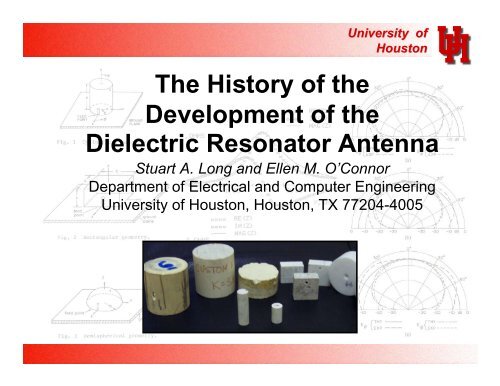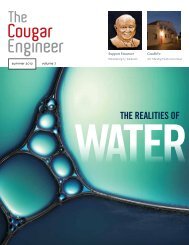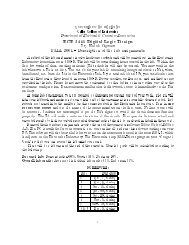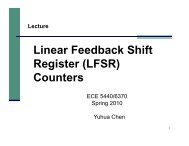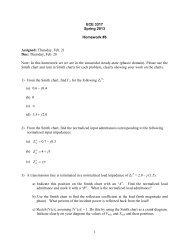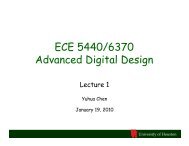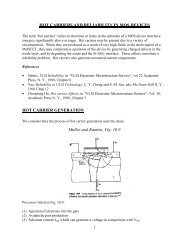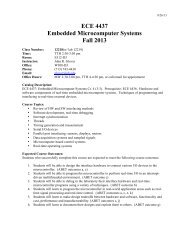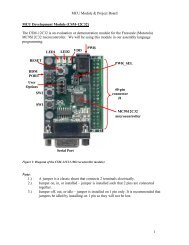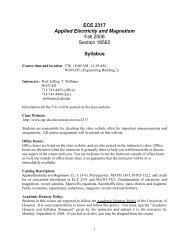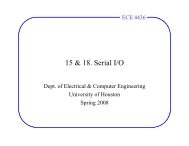The History of the Development of the Dielectric Resonator Antenna
The History of the Development of the Dielectric Resonator Antenna
The History of the Development of the Dielectric Resonator Antenna
Create successful ePaper yourself
Turn your PDF publications into a flip-book with our unique Google optimized e-Paper software.
University <strong>of</strong>Houston<strong>The</strong> <strong>History</strong> <strong>of</strong> <strong>the</strong><strong>Development</strong> <strong>of</strong> <strong>the</strong><strong>Dielectric</strong> <strong>Resonator</strong> <strong>Antenna</strong>Stuart A. Long and Ellen M. O’ConnorDepartment <strong>of</strong> Electrical and Computer EngineeringUniversity <strong>of</strong> Houston, Houston, TX 77204-4005ICEEA '07 -- Sept 20, 2007 0
OutlineUniversity <strong>of</strong>Houston• Origins <strong>of</strong> idea• Simple <strong>the</strong>oretical model• Early experimental data• Initial journal papers• More recent DRA research at <strong>the</strong> University <strong>of</strong> Houston• Worldwide locations <strong>of</strong> DRA activityICEEA '07 -- Sept 20, 2007 1
2) Early <strong>Development</strong> <strong>of</strong> microstrip antennas at <strong>the</strong>University <strong>of</strong> HoustonUniversity <strong>of</strong>Houston• Supported by US ArmyResearch Office• Interest in very ruggedradiators for artillery shellsFormulas developed <strong>the</strong>n are stillused for resonant frequencycalculationsae⎧ 2h⎡ ⎛πa ⎞⎤⎫= a⎨1 + ln 1.7726πaε⎢ ⎜ + ⎟ ⎬r2h⎥⎩ ⎣ ⎝⎠⎦⎭1/2ICEEA '07 -- Sept 20, 2007 3
Problems with microstrip antennasUniversity <strong>of</strong>Houston• Narrow bandwidth for electricallythin substrates• High frequencies result in• More ohmic losses• Electrically thicker substrates whichsupport surface waves and decrease radiation efficiencyICEEA '07 -- Sept 20, 2007 4
<strong>Dielectric</strong> resonatorsUniversity <strong>of</strong>Houston• Used as elements in microwavecircuits• Energy storage devices• Problem with “leakage”ICEEA '07 -- Sept 20, 2007 5
Idea <strong>of</strong> a “dielectric resonator” antenna bornUniversity <strong>of</strong>Houston• Enhance <strong>the</strong> “leakage” or radiationto convert an energy storage deviceinto an antenna• Similar geometry to circularmicrostrip, but without a conductingpatch• Can choose dimensions anddielectric constant to enhanceradiationICEEA '07 -- Sept 20, 2007 6
US Army Harry Diamond LaboratoriesUniversity <strong>of</strong>Houston• In suburban Washington D.C.(Adelphi, MD)• S. Long received a fellowship for Summer1981 to do a feasibility study for new kinds <strong>of</strong>millimeter wave radiators and guidesICEEA '07 -- Sept 20, 2007 7
2) US Army Harry DiamondUniversity <strong>of</strong>Houston• Initial <strong>the</strong>oretical calculationswere doneICEEA '07 -- Sept 20, 2007 8
3) US Army Harry DiamondUniversity <strong>of</strong>Houston• Simple assumption <strong>of</strong> perfect magnetic conducting wallsfor cylindrical geometryICEEA '07 -- Sept 20, 2007 9
Experimental investigationUniversity <strong>of</strong>Houston• Circular cylindrical geometrychosen• Previous use <strong>of</strong> cylindrical shapein microwave circuit resonators• Experience with circular microstripantennas• Availability <strong>of</strong> dielectric material• Fred Farrar aided in experimentalworkICEEA '07 -- Sept 20, 2007 10
<strong>Antenna</strong> designUniversity <strong>of</strong>Houston• Diameter held constant(determined by size <strong>of</strong> rod)• Height, dielectric constant, radialposition <strong>of</strong> feed probe, and length <strong>of</strong>feed probe all varied• <strong>Dielectric</strong> resonator mounted on anconducting ground planeICEEA '07 -- Sept 20, 2007 11
<strong>The</strong>ory for cylindrical geometryUniversity <strong>of</strong>Houston• Input impedance• Resonant frequency• Radiation patternsICEEA '07 -- Sept 20, 2007 12
2) <strong>The</strong>ory for cylindrical geometryUniversity <strong>of</strong>Houston• Input impedance• Resonant frequency• Radiation patternsfnpm21⎧⎪x ⎫np ⎪ ⎡πa ⎤= ⎨ ⎬+ ( 2 + 1)2'2 ⎢mπaμε ⎣ 2 ⎥⎪ ⎪ d ⎦⎩xnp ⎭2ICEEA '07 -- Sept 20, 2007 13
3) <strong>The</strong>ory for cylindrical geometryUniversity <strong>of</strong>Houston• Input impedance• Resonant frequency• Radiation patternsICEEA '07 -- Sept 20, 2007 14
MaterialsUniversity <strong>of</strong>Houston• <strong>Dielectric</strong> rods <strong>of</strong> diameter 1.0” and 0.25”• Various dielectric constants from ε r=6 to ε r =30• Fabricate by simply cutting <strong>of</strong>f desired height <strong>of</strong>resonator• Ultimately discovered that manufacturer’s ε r was notaccurateICEEA '07 -- Sept 20, 2007 15
Fabrication difficultiesUniversity <strong>of</strong>Houston• Materials very hard andabrasive• First tried by hand withhacksaw• <strong>The</strong>n to machinist and powersaw• Finally successful withspecial diamond tipped sawbladesICEEA '07 -- Sept 20, 2007 16
Feed systemUniversity <strong>of</strong>Houston• Chose probe feed toemulate <strong>the</strong> usual microstripantenna feed• Similar fields insideresonator as found in cavity <strong>of</strong>microstrip• Same problems with drilling holes-needed special drill bits• Wanted feed near edge to excitemode with radiation perpendicular toground planeICEEA '07 -- Sept 20, 2007 17
Measurements – cylindrical geometryUniversity <strong>of</strong>Houston• Input impedance• Resonant frequency• Radiation patterns• Varied dimensions to determine behaviorICEEA '07 -- Sept 20, 2007 18
2) Measurements – cylindrical geometry• Input impedance• Resonant frequency• Radiation patterns• Varied dimensions to determinebehaviorUniversity <strong>of</strong>HoustonICEEA '07 -- Sept 20, 2007 19
3) Measurements – cylindrical geometry• Input impedance• Resonant frequency• Radiation patterns• Varied dimensions to determinebehaviorUniversity <strong>of</strong>HoustonICEEA '07 -- Sept 20, 2007 20
4) Measurements – cylindrical geometry• Input impedance• Resonant frequency• Radiation patterns• Varied dimensions to determinebehaviorUniversity <strong>of</strong>Houston Varied height todiameter ratioICEEA '07 -- Sept 20, 2007 21
5) Measurements – cylindrical geometry• Input impedance• Resonant frequency• Radiation patterns• Varied dimensions to determinebehavior Varied ε rUniversity <strong>of</strong>HoustonICEEA '07 -- Sept 20, 2007 22
6) Measurements – cylindrical geometryUniversity <strong>of</strong>Houston• Input impedance• Resonant frequency• Radiation patterns• Varied dimensions to determine behavior Varied probe lengthICEEA '07 -- Sept 20, 2007 23
ResultsUniversity <strong>of</strong>Houston• With proper choice <strong>of</strong> dimensions and dielectric constant• <strong>Antenna</strong> that wasEfficient radiatorEasily matched to a 50Ω transmission lineBroad pattern with maximum normal to groundplaneBonus: much larger bandwidth than microstrip antennawhen lower dielectric constants usedICEEA '07 -- Sept 20, 2007 24
Fall 1981University <strong>of</strong>Houston• Back at <strong>the</strong> University <strong>of</strong> Houston• Mark McAllister, a new PhD student was justready to start his research projectBegan a much more systematic investigation<strong>of</strong> <strong>the</strong>se cylindrical DRAsICEEA '07 -- Sept 20, 2007 25
Rectangular and hemispherical DRAsUniversity <strong>of</strong>Houston• Expanded investigation to includeandrectangularhemisphericalICEEA '07 -- Sept 20, 2007 26
Feed systems for o<strong>the</strong>r geometriesUniversity <strong>of</strong>Houston• Continued to use probe feedsHemisphericalRectangularICEEA '07 -- Sept 20, 2007 27
O<strong>the</strong>r geometries data: rectangularUniversity <strong>of</strong>HoustonICEEA '07 -- Sept 20, 2007 28
2) O<strong>the</strong>r geometries data: hemisphericalUniversity <strong>of</strong>HoustonHemisphericalICEEA '07 -- Sept 20, 2007 29
Mark McAllisterUniversity <strong>of</strong>Houston• Completed PhD in 1983• Career at Stanford ResearchInstitute and Bell Telephone• Retired from engineeringNow a budding novelistICEEA '07 -- Sept 20, 2007 30
First DRA paperUniversity <strong>of</strong>Houston• Submitted April 5, 1982• Published by IEEE <strong>Antenna</strong>s and Propagation,May 1983•Reported results for <strong>the</strong> cylindrical geometry•Note: Title called it a “Resonant Cylindrical <strong>Dielectric</strong> Cavity<strong>Antenna</strong>” (RDCA) -- paper now cited over 196 timesICEEA '07 -- Sept 20, 2007 31
Second DRA paperUniversity <strong>of</strong>Houston• Reported <strong>the</strong> rectangular shaped radiatorSubmitted February 7, 1983Published March 17, 1983 in Electronics Letters• Submitted almost one year after <strong>the</strong> first paper, but actuallypublished slightly before.• Note: Title <strong>of</strong> Rectangular <strong>Dielectric</strong> <strong>Resonator</strong> <strong>Antenna</strong> wasname that eventually “stuck” and later abbreviated as DRAICEEA '07 -- Sept 20, 2007 32
Hemispherical DRAUniversity <strong>of</strong>Houston• Reported <strong>the</strong> hemispherical shaped radiatorSubmitted June 1984Published in Electronics Letters August 1984•Note: Here called “Resonant Hemispherical <strong>Dielectric</strong> <strong>Antenna</strong>”(RDA)ICEEA '07 -- Sept 20, 2007 33
Feed MechanismsUniversity <strong>of</strong>Houston• For more “integrated” applicationsfeeds o<strong>the</strong>r than probes are moreappropriateRoger Kranenburg, 1988• New graduate student – Roger KranenburgICEEA '07 -- Sept 20, 2007 34
2) Feed MechanismsUniversity <strong>of</strong>Houston• Microstrip - Electronics Letters, September 1988ICEEA '07 -- Sept 20, 2007 35
3) Feed MechanismsUniversity <strong>of</strong>Houston• Microstrip - Electronics Letters, September 1988ICEEA '07 -- Sept 20, 2007 36
4) Feed MechanismsUniversity <strong>of</strong>Houston• Coplanar Waveguide - IEEE <strong>Antenna</strong>s and Propagation,January 1991ICEEA '07 -- Sept 20, 2007 37
5) Feed MechanismsUniversity <strong>of</strong>Houston• Coplanar Waveguide - IEEE <strong>Antenna</strong>s and Propagation, January 1991ICEEA '07 -- Sept 20, 2007 38
More recent work at <strong>the</strong> University <strong>of</strong> HoustonUniversity <strong>of</strong>Houston• Parasitic Strips – Russell Long, Electronics Letters, 2001Russell Long, 2001zdaφGround planeFeedstructureParasitic stripICEEA '07 -- Sept 20, 2007 39
S11 [dB]VSWR2) More recent work at <strong>the</strong> University <strong>of</strong> HoustonUniversity <strong>of</strong>Houston• Parasitic Strips – Russell Long, Electronics Letters 20015-54-1532-252.0 2.2 2.4 2.6 2.8 2.9Frequency [GHz]Fig 2. Reflection coefficient (S11) versus frequency for varying positions<strong>of</strong> parasitic stripNo Parasitic Strip110°130°150°180°12.0 2.2 2.4 2.6 2.8Frequency [GHz]Fig 4. SWR versus frequency for antenna with andwithout parasitic stripWith Parasitic StripNo Parasitic StripICEEA '07 -- Sept 20, 2007 40
University <strong>of</strong>Houston3) More recent work at <strong>the</strong> University <strong>of</strong> Houston• Mutual Coupling – Robert Dorris, AWPL, 2002Robert Dorris, 2002zθfeeddxaφεyground planeICEEA '07 -- Sept 20, 2007 41
4) More recent work at <strong>the</strong> University <strong>of</strong> HoustonzθUniversity <strong>of</strong>Houstonεdyfeedaxg round planeφ• Mutual Coupling – Robert Dorris, AWPL, 2002-5Coupling Magnitude (dB)-15-25-35-450 1 2 3 4Distance (Wavelength)Fig. 4 Coupling magnitude versus spacing distance in wavelengths- Measured E-plane- Measured H-plane- Previous E-plane data- Previous H-plane dataICEEA '07 -- Sept 20, 2007 42
5) More recent work at <strong>the</strong> University <strong>of</strong> HoustonUniversity <strong>of</strong>Houston• Low Pr<strong>of</strong>ile DRA – Ben Fastenfest, Electronics Letters, 2003Ben Fastenfest, 2003ICEEA '07 -- Sept 20, 2007 43
6) More recent work at <strong>the</strong> University <strong>of</strong> HoustonUniversity <strong>of</strong>Houston• Low Pr<strong>of</strong>ile DRA – Ben Fastenfest, Electronics Letters, 2003150Impedance (Ohms)1005002.1 2.2 2.3 2.4 2.5-50Frequency (GHz)Fig 2. Measured impedance vs. frequency for nowell case and for s = 40 mm (a/d = 1.5)150100500-50No Well Re(Zin)No Well Im(Zin)s=40mm Re(Zin)s=40mm Im(Zin)2.1 2.2 2.3 2.4 2.5Fr equency (GHz)Fig 5. Radiation patterns in dB for no well case and for s = 40mm (a/d = 0.5)ICEEA '07 -- Sept 20, 2007 44
University <strong>of</strong>7) More recent work at <strong>the</strong> University <strong>of</strong> Houston Houston• Stacked Embedded DRA – Andrew Walsh, AWPL, 2006Andrew Walsh, 2006ICEEA '07 -- Sept 20, 2007 45
8) More recent work at <strong>the</strong> University <strong>of</strong> HoustonUniversity <strong>of</strong>Houston• Stacked Embedded DRA – Andrew Walsh, AWPL, 2006250-20Input Reflection Coefficient (dB)20-10Bandwidth (%)1510ε r.upper = 15.2ε r.lower = 6.0-30a = 68.1 %b = 50.7 %c = 59.9 %d = 21.0 %5-4000 0.1 0.2 0.3 0.4 0.5 0.6 0.7 0.8 0.9 1dlower/d (unitless)Stacked DRAHomogeneous DRAFigure 3. Percent bandwidth vs variation in height <strong>of</strong> <strong>the</strong>lower section <strong>of</strong> <strong>the</strong> DRA, <strong>the</strong> permittivity <strong>of</strong> <strong>the</strong> top andbottom sections are fixed at 15.2 and 6.0 respectively-502.5 3 3.5 4 4.5 5Frequency (GHz)(a) Embedded Stacked DRA(c) Stacked DRA(b) Core-Plug Embedded DRA(d) Homogeneous DRAFigure 8. Reflection coefficient for antennas previouslyshown in Figure 7 with <strong>the</strong> corresponding percent bandwidthICEEA '07 -- Sept 20, 2007 46
9) More recent work at <strong>the</strong> University <strong>of</strong> HoustonUniversity <strong>of</strong>Houston• Multimode Wideband DRA – Chris DeYoung, AWPL, 2006Chris DeYoung, 2006zzl w ahdxyxyICEEA '07 -- Sept 20, 2007 47
10) More recent work at <strong>the</strong> University <strong>of</strong> HoustonUniversity <strong>of</strong>Houstonzzl w a• Multimode Wideband DRA – Chris DeYoung, AWPL, 2006hdxyxyICEEA '07 -- Sept 20, 2007 48
DRAs: O<strong>the</strong>r institutionsUniversity <strong>of</strong>Houston• Shortly after <strong>the</strong> first papers out <strong>of</strong> <strong>the</strong> University OfHouston various groups began publishing DRAarticlesA. Kishk, S. Long, and K.W. LeungICEEA '07 -- Sept 20, 2007 49
DRAs around <strong>the</strong> worldUniversity <strong>of</strong>HoustonICEEA '07 -- Sept 20, 2007 50
DRAs around <strong>the</strong> worldUniversity <strong>of</strong>HoustonUniversity <strong>of</strong> Houston- Long, Shen and McAllisterICEEA '07 -- Sept 20, 2007 51
DRAs around <strong>the</strong> worldUniversity <strong>of</strong>HoustonSaitama University in Japan- Haneishi and colleaguesICEEA '07 -- Sept 20, 2007 52
2) DRAs around <strong>the</strong> worldUniversity <strong>of</strong>HoustonUniversity <strong>of</strong> Mississippi- Kishk, Glisson, Kajfiz, Ahn,Eisherbeni, and JunkerICEEA '07 -- Sept 20, 2007 53
3) DRAs around <strong>the</strong> worldUniversity <strong>of</strong>HoustonCommunications Research Centre(CRC) in Ottawa-Ittpiboon, Mongia, Antar,Barthia, Petosa, Cuhaci, and RoscoeICEEA '07 -- Sept 20, 2007 54
4) DRAs around <strong>the</strong> worldUniversity <strong>of</strong>HoustonCity University <strong>of</strong> Hong Kong-Leung and LukICEEA '07 -- Sept 20, 2007 55
5) DRAs around <strong>the</strong> worldUniversity <strong>of</strong>Houston<strong>The</strong> University <strong>of</strong> Manchester-Drossos, Wu, and DavisICEEA '07 -- Sept 20, 2007 56
6) DRAs around <strong>the</strong> worldUniversity <strong>of</strong>HoustonMacquarie University, Sydney, Australia.- EsselleICEEA '07 -- Sept 20, 2007 57
7) DRAs around <strong>the</strong> worldUniversity <strong>of</strong>HoustonUniversity <strong>of</strong> Calcutta- GuhaICEEA '07 -- Sept 20, 2007 58
8) DRAs around <strong>the</strong> worldUniversity <strong>of</strong>HoustonETHEidgenössische Technische Hochschule ZürichSwiss Federal Institute <strong>of</strong> Technology ZürichETH Zürich- Almpanis, Fumeaux, and VahldieckICEEA '07 -- Sept 20, 2007 59
9) DRAs around <strong>the</strong> worldUniversity <strong>of</strong>HoustonRoyal Military College <strong>of</strong> Canada-AntarICEEA '07 -- Sept 20, 2007 60
10) DRAs around <strong>the</strong> worldUniversity <strong>of</strong>HoustonInstitute for Infocomm Research, Singapore.- NasimuddinICEEA '07 -- Sept 20, 2007 61
DRA TextbooksUniversity <strong>of</strong>Houston• <strong>Dielectric</strong> <strong>Resonator</strong> <strong>Antenna</strong>sby K.M. Luk and K.W. Leung• Jun 1, 2002• Research Studies Press• 380 pagesICEEA '07 -- Sept 20, 2007 62
2) DRA TextbooksUniversity <strong>of</strong>Houston• <strong>Dielectric</strong> <strong>Resonator</strong> <strong>Antenna</strong>Handbook by A. Petosa• January 31, 2007• Artech House Publishers• 336 pagesICEEA '07 -- Sept 20, 2007 63
Growth <strong>of</strong> DRA publicationsUniversity <strong>of</strong>Houston<strong>The</strong> number <strong>of</strong> published journalarticles and conference proceedingsis growing each yearICEEA '07 -- Sept 20, 2007 64
2) Growth <strong>of</strong> DRA publicationsUniversity <strong>of</strong>Houston1980’s 1990’s 2000’sICEEA '07 -- Sept 20, 2007 65
<strong>The</strong> future <strong>of</strong> DRAsUniversity <strong>of</strong>Houston• Idea ahead <strong>of</strong> its time• As operating frequencies continue to rise, DRAs willbecome much more useful.• Need to develop integration techniques for fabrication• Someday may be as common as microstrip antennasICEEA '07 -- Sept 20, 2007 66
Original DRA samplesUniversity <strong>of</strong>Houston• Some <strong>of</strong> <strong>the</strong> original DRAs (fabricated atHarry Diamond Labs) for each presenterICEEA '07 -- Sept 20, 2007 67
Bibliography CDUniversity <strong>of</strong>Houston• All <strong>of</strong> <strong>the</strong> journal articles and conferenceproceedings we could findICEEA '07 -- Sept 20, 2007 68
Remainder <strong>of</strong> Session 27University <strong>of</strong>Houston9:00 AM D. Guha - University <strong>of</strong> CalcuttaY.M.M. Antar - Royal Military College <strong>of</strong> CanadaNovel Designs <strong>of</strong> <strong>Dielectric</strong> <strong>Resonator</strong> <strong>Antenna</strong>s for Wireless Communications9:20 AM Y. Ding, K.W. Leung, K.M. Luk - City University <strong>of</strong> Hong KongCircularly-Polarized DRA-Slot Hybrid <strong>Antenna</strong> for Dualband Applications9:40 AM Z. Wu – University <strong>of</strong> ManchesterBroadband Miniaturised <strong>Dielectric</strong> <strong>Resonator</strong> <strong>Antenna</strong>s10:00 AM C<strong>of</strong>fee Break10:20 AM G. Almpanis, C. Fumeaux, and R. Vahldieck - ETH ZürichComparison <strong>of</strong> <strong>the</strong> Performance <strong>of</strong> Double-Step Rectangular <strong>Dielectric</strong><strong>Resonator</strong> <strong>Antenna</strong>s10:40 AM S. Thirakoune, A. Petosa, A. Ittipiboon – CRC OttawaYagi-like DRA-Loaded Monopole11:00 AM Nasimuddin - Institute for Infocomm Research, SingaporeK. P. Esselle - Macquarie UniversityAchieving high gain and large bandwidth using hybrid DR antennas to feed short hornsICEEA '07 -- Sept 20, 2007 69


